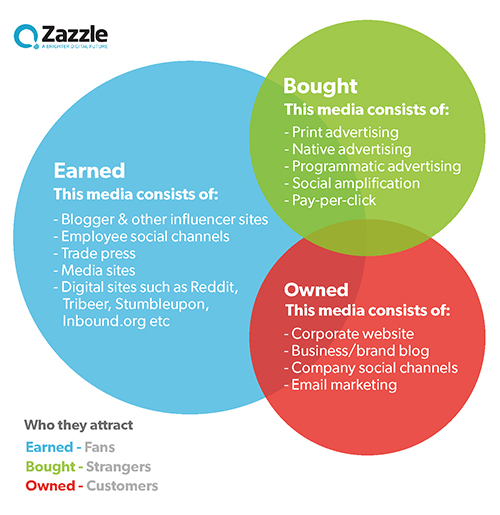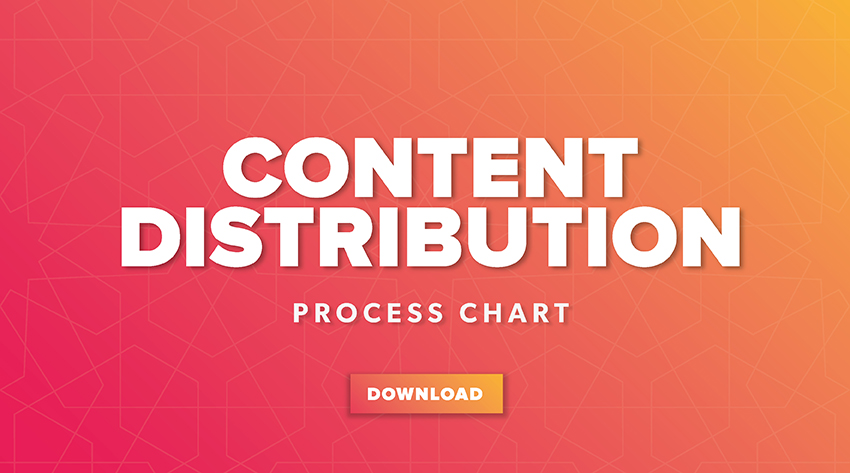We all know that in today’s digital world, content is king. It is the lifeblood of business success: the key to increasing rankings in the SERPs, building brand awareness, and ultimately attracting new customers. Creative campaigns that go viral and set the web on fire are what every brand strives for. However, it is often easy to become too focused on the production of an idea, rather than the PR activity and distribution of the end result.
At the end of the day, it really doesn’t matter how good the idea is; if you don’t have a clear and comprehensive PR/distribution plan, you are leaving its success to chance. The visual below shows us the available channels for a distribution plan - having them overlap is how to create effective and wide reaching coverage for your content.

Here, we have created a downloadable guide to simplify the process; identifying the many different channels available, and the ways in which you can use them to get your content in front of as many people as possible.
It is important that you define the wording/messaging you want to use to promote your campaign, as well as staggering the deadlines of any supporting promotion to avoid overkill. Now let's get started, and get to the bottom of how to create a PR plan that will distribute your content effectively.
Identifying your audience
It may sound obvious, but the first thing you need to do before you start the PR process is to understand how your audience interacts and engages with content and on what platforms – mobile, desktop, tablet or even print.
Information from market research companies such as Global Web Index (GWI) can help you understand the online behaviour of your audience, detailing how your audience discovers new brands (eg. via customer reviews, a blog, a forum or directory, a price comparison site), what sites they have visited over the last 30 days (eg. business news sites, social networking, your own website) and what they really want from you and your content (eg. information to improve their knowledge or connect with others).
Combining this information with what you already know about your customers helps you draw up a clear picture your audience and how they absorb or find information.
Distribution options
Let’s go back to basics. There are three main distribution channels you need to include in your plan – owned, earned and paid. All are important, producing different results and requiring different levels of effort.
What are Owned marketing channels?
This is using your own channels, where you can control the content; such as your website – including any eBooks and white papers you have produced and host on site – as well as your blog and business’ social media platforms. Don’t just think Facebook, Twitter and LinkedIn, but also consider other social channels such as YouTube, Instagram, Pinterest and Snapchat.
Email marketing also comes under owned. Although building a subscriber list is hard work, it is a useful and effective distribution tool, promoting new and interesting content to people who already know about you and are interested in what you do/can offer.
Although owned media is considered to be free, you do need to factor in the amount of time needed to maintain it. Building an online community is time consuming but worthwhile for your engagement and brand recognition. When it comes to creating content for your owned channels, check out our content FAQ's to answer some initial questions you might have.
What are Earned marketing channels?
Earned media involves others sharing your content. It is, in essence, the equivalent of online word of mouth and is the vehicle that drives traffic, engagement and sentiment around a brand.
External distribution channels give brands access to a new and bigger audience pool and can take several forms:
- PR coverage in the media or trade press, where they publishing an article promoting the content you have created, or bloggers and other influencers writing and linking back to your content.
- Sharing from individuals social accounts – in particular customers already following you, whether that’s on Facebook, Twitter, LinkedIn, Pinterest, Instagram etc, and, of course, staff.
- Submitting content to other digital platforms. This can also include any off-page blogs you write, where your supporting content for any given campaign can come into play. There are many different sorts of other digital platforms available for you to share content so it is best to research and test the right ones for your audience, however some we’d recommend include:
- Reddit - By searching and targeting relevant subreddits (categories) tailored to your content, you will get it in front of people who are generally interested in it and will go on and share it with others.
- Stumbleupon –This social platform is often overlooked, but just as with Reddit, you can submit content to it and share it with people with similar interests that either you follow or follow you.
- Scoop.it – A content sharing site, where you create boards of content around a particular theme for others to follow.
- Tribeer – This is a community of bloggers that share each others content via a tribe (a group of people who have content on a similar theme that you build a relationship with). If you join the right tribes, your content will be shared.
- Inbound.org – This is a place to share digital marketing related content and is a good place to keep on top of industry trends.
What are Paid marketing channels?
Of course we all want our content to be shared organically, but we have to be realistic and understand that to get it in front of as many eyeballs as possible, we may need to pay for it.
There are a wide variety of different platforms to use, again depending on your audience, from the traditional – TV/radio/print adverts, which tend to be very expensive and not particularly targeted – to native and programmatic, which is more personalised.
Native advertising is basically like an old print advertorial - where a business pays for a promotional piece of content to be written and published about them – but in this instance, instead of being in print, it is hosted online, on a site that is relevant to the content itself or identified as one the brand’s audience is on.
Programmatic advertising is believed to be the future of online advertising and basically refers to any ad space bought automatically on a web page, by either bidding for the space or buying it directly.
Other distribution channels worth considering are Outbrain or Taboola – which promote your content or brand at the end of an article on a similar theme/topic.
And, don’t forget paid social amplification too, such as Facebook sponsored posts, where you pay to boost your posts and get them shared with more users, based on demographic/interests, or the Twitter dashboard, where you pay to promote your tweets.
Facebook advertising is relatively cost effective. You can set a daily limit for one advert or a total amount for a specific campaign. Facebook advert are highly targeted as you can choose the people you want to reach.
And, there is also PPC (pay-per-click). Essentially, it is a way of buying visits to your site/content and the most popular form is Search Engine advertising, where advertisers bid for a placement in the sponsored links section and when someone searches on a keyword that is related to their business offering, the advert shows up in the tip spot of the results page.
Conclusion
The best way to ensure you cover all bases in getting the content in front of as many people as possible, is to create a detailed distribution plan, where you consider every channel available - refer to the image at the start of this blog to remind yourself of your available channels and where they overlap.
Remember, it is important to test a variety of channels, as owned, earned or paid each has its own role, but together will make your digital media strategy much more effective and ensure all the hard work that has gone into producing your content is worth it and, most importantly, achieves its objectives.
And don't forget to claim your free process download to help below!
Sign up for our monthly newsletter and follow us on social media for the latest news.





 Proudly part of IPG Mediabrands
Proudly part of IPG Mediabrands